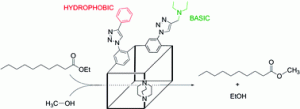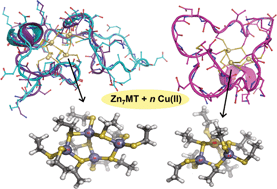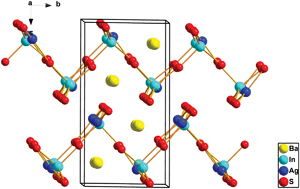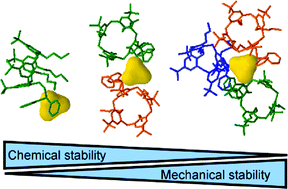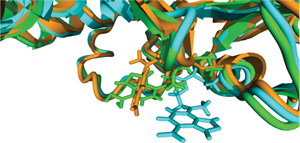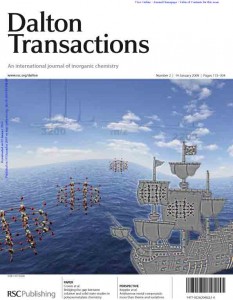This month sees the following articles in Dalton Transactions that are in the top ten most accessed:-
Water oxidation catalysed by manganese compounds: from complexes to ‘biomimetic rocks’
Mathias Wiechen, Hans-Martin Berends and Philipp Kurz
Dalton Trans., 2012, 41, 21-31 DOI:10.1039/c1dt11537e
Self-assembly in inorganic chemistry
Paul E. Kruger and Thorfinnur Gunnlaugsson
Dalton Trans., 2011, 40, 12003-12004 DOI:10.1039/c1dt90162a
Paramagnetic metal complexes of diamido donor ligands
Cassandra E. Hayes and Daniel B. Leznoff
Dalton Trans., 2012, Advance Article DOI:10.1039/c1dt11559f
A series of pillar-layer metal?organic frameworks based on 5-aminoisophthalic acid and 4,4′-bipyridine
Hai-Ning Wang, Xing Meng, Chao Qin, Xin-Long Wang, Guang-Sheng Yang and Zhong-Min Su
Dalton Trans., 2012, 41, 1047-1053 DOI:10.1039/c1dt11304f
The future of metal-organic frameworks
Neil R. Champness
Dalton Trans., 2011, 40, 10311-10315 DOI:10.1039/c1dt11184a
A cationic iridium(iii) complex showing aggregation-induced phosphorescent emission (AIPE) in the solid state: synthesis, characterization and properties
Guo-Gang Shan, Ling-Yu Zhang, Hai-Bin Li, Shuang Wang, Dong-Xia Zhu, Peng Li, Chun-Gang Wang, Zhong-Min Su and Yi Liao
Dalton Trans., 2012, 523-530 DOI:10.1039/c1dt11215e
The structure and reactivity of iron nitride complexes
Jeremy M. Smith and Deepak Subedi
Dalton Trans., 2012, Advance Article DOI:10.1039/c1dt11674f
A novel Zn4O-based triazolyl benzoate MOF: synthesis, crystal structure, adsorption properties and solid state 13C NMR investigations
Jörg Lincke, Daniel Lässig, Karolin Stein, Jens Moellmer, Anusree Viswanath Kuttatheyil, Christian Reichenbach, Andreas Moeller, Reiner Staudt, Grit Kalies, Marko Bertmer and Harald Krautscheid
Dalton Trans., 2012, 817-824 DOI:10.1039/c1dt11431j
Stepwise synthesis of a hydrido, N-heterocyclic dicarbene iridium(iii) pincer complex featuring mixed NHC/abnormal NHC ligands
Weiwei Zuo and Pierre Braunstein
Dalton Trans., 2012, 41, 636-643 DOI:10.1039/c1dt11511a
Luminescent Ir(iii) complexes containing benzothiazole-based tridentate ligands: synthesis, characterization, and application to organic light-emitting diodes
Junpei Kuwabara, Tomomi Namekawa, Masa-aki Haga and Takaki Kanbara
Dalton Trans., 2012, 41, 44-46 DOI:10.1039/c1dt11560j
Why not take a look at the articles today and blog your thoughts and comments below.
Fancy submitting an article to Dalton Transactions? Then why not submit to us today or alternatively email us your suggestions.
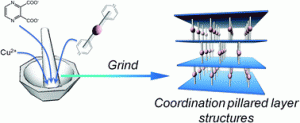 In their recent Dalton Transactions Hot Article, Susumu Kitagawa and colleagues show that mechanochemical synthesis is a promising alternative method for the systematic and large-scale production of porous coordination polymers (PCPs).
In their recent Dalton Transactions Hot Article, Susumu Kitagawa and colleagues show that mechanochemical synthesis is a promising alternative method for the systematic and large-scale production of porous coordination polymers (PCPs). Read Kitagawa’s study for free until the 20th February:
Read Kitagawa’s study for free until the 20th February:










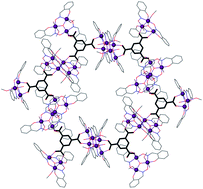

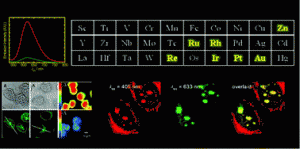 K
K 